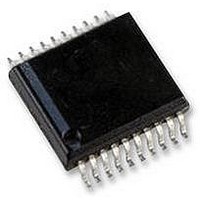BD4154FV-E2 Rohm Semiconductor, BD4154FV-E2 Datasheet - Page 24

BD4154FV-E2
Manufacturer Part Number
BD4154FV-E2
Description
POWER SWITCH EXPRESS CARD, SSOP-B20
Manufacturer
Rohm Semiconductor
Series
-r
Specifications of BD4154FV-E2
Primary Input Voltage
3.6V
No. Of Outputs
1
Output Voltage
5V
Output Current
1.3A
Voltage Regulator Case Style
SSOP
No. Of Pins
20
Operating Temperature Range
-40°C To +100°C
Svhc
No SVHC
Applications
PCMCIA, ExpressCard™
Current - Supply
250µA
Voltage - Supply
3 V ~ 3.6 V
Operating Temperature
-40°C ~ 100°C
Mounting Type
Surface Mount
Package / Case
20-TSSOP (0.173", 4.40mm Width)
Lead Free Status / RoHS Status
Lead free / RoHS Compliant
●NOTE FOR USE
1.Absolute maximum ratings
2.GND potential
3.Thermal design
4.Terminal-to-terminal short-circuit and erroneous mounting
5.Operation in strong electromagnetic field
6.Built-in thermal shutdown protection circuit
7.Capacitor across output and GND
8.Inspection by set substrate
9.IC terminal input
For the present product, thoroughgoing quality control is carried out, but in the event that applied voltage, working
temperature range, and other absolute maximum rating are exceeded, the present product may be destroyed. Because it
is unable to identify the short mode, open mode, etc., if any special mode is assumed, which exceeds the absolute
maximum rating, physical safety measures are requested to be taken, such as fuses, etc.
Bring the GND terminal potential to the minimum potential in any operating condition.
Consider allowable loss (Pd) under actual working condition and carry out thermal design with sufficient margin provided.
When the present IC is mounted to a printed circuit board, take utmost care to direction of IC and displacement. In the
event that the IC is mounted erroneously, IC may be destroyed. In the event of short-circuit caused by foreign matter that
enters in a clearance between outputs or output and power-GND, the IC may be destroyed.
The use of the present IC in the strong electromagnetic field may result in maloperation, to which care must be taken.
The present IC incorporates a thermal shutdown protection circuit (TSD circuit). The working temperature is 175°C
(standard value) and has a -15°C (standard value) hysteresis width. When the IC chip temperature rises and the TSD
circuit operates, the output terminal is brought to the OFF state. The built-in thermal shutdown protection circuit (TSD
circuit) is first and foremost intended for interrupt IC from thermal runaway, and is not intended to protect and warrant the IC.
Consequently, never attempt to continuously use the IC after this circuit is activated or to use the circuit with the activation of
the circuit premised.
In the event a large capacitor is connected across output and GND, when Vcc and VIN are short-circuited with 0V or GND
for some kind of reasons, current charged in the capacitor flows into the output and may destroy the IC. Use a capacitor
smaller than 1000 µF between output and GND.
In the event a capacitor is connected to a pin with low impedance at the time of inspection with a set substrate, there is a
fear of applying stress to the IC. Therefore, be sure to discharge electricity for every process. As electrostatic measures,
provide grounding in the assembly process, and take utmost care in transportation and storage. Furthermore, when the
set substrate is connected to a jig in the inspection process, be sure to turn OFF power supply to connect the jig and be sure
to turn OFF power supply to remove the jig.
The present IC is a monolithic IC and has a P substrate and P
With this P layer and N layer of each element, PN junction is formed, and when the potential relation is
The parasitic element is inevitably formed because of the IC construction. The operation of the parasitic element gives rise
to mutual interference between circuits and results in malfunction, and eventually, breakdown. Consequently, take utmost
care not to use the IC to operate the parasitic element such as applying voltage lower than GND (P substrate) to the input
terminal.
(PIN A)
N
GND>terminal A>terminal B, PN junction works as a diode, and
terminal B>GND terminal A, PN junction operates as a parasitic transistor.
P+
P substrate
Resistor
N
GND
P
Parasitic diode
P+
N
(PIN B)
N
Parasitic diode
P+
C
24/28
NPN Transistor Structure (NPN)
P substrate
B
N
N
+
isolation between elements.
GND
P
E
P+
N
GND
Nearby other device
(PIN A)
(PIN B)
GND
B
Parasitic diode
GND
Parasitic diode
C
E










